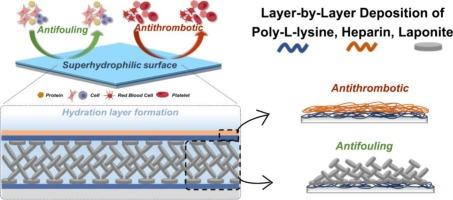Synergistic coating of Laponite swollen-layer and heparin composite for enhanced antifouling and antithrombotic performance
IF 12.5
1区 化学
Q1 CHEMISTRY, APPLIED
引用次数: 0
Abstract
When implantable medical devices come into contact with blood, acute thrombosis and inflammation often occur due to the adhesion and denaturation of plasma proteins, ultimately degrading device performance. To address this issue, we developed a gel-like coating with superhydrophilic properties, incorporating a heparin based outer layer designed to minimize foreign body reactions and enhance hemocompatibility. The coating was engineered using a layer-by-layer (LbL) assembly of poly-l-lysine (PLL), laponite (Lap), and heparin (Hep), utilizing electrostatic interactions. The successful formation of stable layers was confirmed by QCM-D analysis. The inner layer, composed of PLL/Lap multilayers, formed a gel-like structure that maintained superhydrophilicity and effectively prevented cell adhesion. The outermost PLL/Hep multilayers significantly suppressed thrombus formation by inhibiting plasma protein and red blood cell adsorption as well as platelet activation. The coating exhibited excellent stability, retaining its superhydrophilic properties and heparin functionality even after 7 days of immersion in DPBS. Additionally, in vitro hemocompatibility and cytocompatibility tests confirmed its non-toxicity and overall biocompatibility. These results highlight the potential application of this coating to various implantable medical devices, providing a robust solution for improving device performance and safety.

增强防污和抗血栓性能的皂石膨胀层和肝素复合材料协同涂层
当植入式医疗器械与血液接触时,由于血浆蛋白的粘附和变性,往往会出现急性血栓和炎症,最终导致器械性能下降。为了解决这个问题,我们开发了一种具有超亲水性能的凝胶状涂层,并在其外层加入了肝素,旨在最大限度地减少异物反应并增强血液相容性。这种涂层是利用静电相互作用,将聚赖氨酸(PLL)、青石棉(Lap)和肝素(Hep)逐层(LbL)组装而成的。QCM-D 分析证实了稳定层的成功形成。由 PLL/Lap 多层膜组成的内层形成了凝胶状结构,可保持超亲水性并有效防止细胞粘附。最外层的 PLL/Hep 多层膜抑制了血浆蛋白和红细胞的吸附以及血小板的活化,从而显著抑制了血栓的形成。涂层具有极佳的稳定性,在 DPBS 中浸泡 7 天后仍能保持其超亲水性和肝素功能。此外,体外血液相容性和细胞相容性测试证实了它的无毒性和整体生物相容性。这些结果凸显了这种涂层在各种植入式医疗设备中的潜在应用,为提高设备性能和安全性提供了强有力的解决方案。
本文章由计算机程序翻译,如有差异,请以英文原文为准。
求助全文
约1分钟内获得全文
求助全文
来源期刊

Carbohydrate Polymers
化学-高分子科学
CiteScore
22.40
自引率
8.00%
发文量
1286
审稿时长
47 days
期刊介绍:
Carbohydrate Polymers stands as a prominent journal in the glycoscience field, dedicated to exploring and harnessing the potential of polysaccharides with applications spanning bioenergy, bioplastics, biomaterials, biorefining, chemistry, drug delivery, food, health, nanotechnology, packaging, paper, pharmaceuticals, medicine, oil recovery, textiles, tissue engineering, wood, and various aspects of glycoscience.
The journal emphasizes the central role of well-characterized carbohydrate polymers, highlighting their significance as the primary focus rather than a peripheral topic. Each paper must prominently feature at least one named carbohydrate polymer, evident in both citation and title, with a commitment to innovative research that advances scientific knowledge.
 求助内容:
求助内容: 应助结果提醒方式:
应助结果提醒方式:


